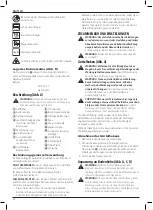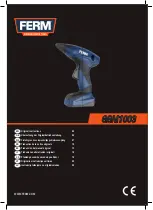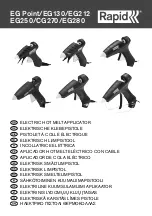
40
EnGLIsh
To Remove the Battery Pack from the Tool
1. Press the release button
13
and firmly pull the battery pack
out of the tool handle.
2. Insert battery pack into the charger as described in the
charger section of this manual.
Fuel Gauge Battery Packs (Fig. B)
Some
D
e
WALT
battery packs include a fuel gauge which
consists of three green LED lights that indicate the level of
charge remaining in the battery pack.
To actuate the fuel gauge, press and hold the fuel gauge button.
A combination of the three green LED lights will illuminate
designating the level of charge left. When the level of charge
in the battery is below the usable limit, the fuel gauge will not
illuminate and the battery will need to be recharged.
nOTE:
The fuel gauge is only an indication of the charge left on
the battery pack. It does not indicate tool functionality and is
subject to variation based on product components, temperature
and end-user application.
OPERATION
Instructions for Use
WARNING:
Always observe the safety instructions and
applicable regulations.
WARNING:
If the tool has been dropped or you
suspect tool damage perform tool operation check
as defined in the mode selection section of the
manual.
If it does not perform according to the manual,
stop using the tool and have it serviced at an authorized
D
e
WALT
Service Centre.
WARNING: To reduce the risk of serious personal
injury, turn tool off and disconnect battery pack
before making any adjustments or removing/
installing attachments or accessories.
An accidental
start-up can cause injury.
Proper Hand Position (Fig. E)
WARNING:
To reduce the risk of serious personal injury,
ALWAYS
use proper hand position as shown.
WARNING:
To reduce the risk of serious personal
injury,
ALWAYS
hold securely in anticipation of a
sudden reaction.
Proper hand position requires one hand on the main handle
as shown.
Preparing the Tool
WARNING: NEVER
spray or in any other way apply
lubricants or cleaning solvents inside the tool.
This
can seriously affect the life and performance of the tool.
nOTE:
The battery pack is not fully charged out of the carton.
Follow instructions outlined (see
Charging a Battery
).
1.
Read the Safety Instruction section of this manual.
2. Wear eye and ear protection.
3. Ensure magazine is empty of all fasteners.
4. Check for smooth and proper operation of contact trip and
pusher assemblies. Do not use tool if either assembly is not
functioning properly.
NEVER
use a tool that has the contact
trip restrained in the actuated position.
5. Keep tool pointed away from yourself and others.
6. Insert fully charged battery pack.
Using the Trigger Lock-off (Fig. G)
WARNING: To reduce the risk of serious personal
injury, do not keep trigger depressed when tool
is not in use.
Keep the trigger lock-off switch LOCKED
(Fig. G) when the tool is not in use.
WARNING:
To reduce the risk of serious personal
injury, lock off trigger, disconnect battery pack from
tool and remove staples from magazine before
making adjustments.
Each
D
e
WALT
stapler is equipped with a trigger lock-off
2
which when pushed to the right as shown in Figure G, prevents
the tool from firing a staple by locking the trigger and bypassing
power to the motor.
When the trigger lock-off is pressed to the left, the tool will be
fully operational. The trigger lock-off should always be locked
off whenever any adjustments are made or when tool is not in
immediate use.
NOTICE:
Do not store tool with battery pack installed. To
prevent damage to the pack and to ensure best battery
life, store battery packs out of the tool or charger in a cool,
dry location.
Loading the Tool (Fig. A, H)
WARNING:
Keep the tool pointed away from yourself and
others. Serious personal injury may result.
WARNING:
Never load staples with the contact trip or
trigger activated. Personal injury may result.
WARNING:
Always remove battery pack before loading or
unloading staples. Serious personal injury may result.
1. Press magazine latch
14
and open sliding
magazine
6
fully.
2. Insert fasteners into the side of magazine; fasteners should
be loaded with head against back of magazine.
3. Close sliding magazine until the magazine latch
clips snuggly.
Unloading the Tool (Fig. H)
WARNING:
The trigger lock-off should always be locked
off whenever any adjustments are made or when tool is
not in use.
1. Press magazine latch
14
and open sliding
magazine
6
fully.
2. Tip the tool up until the staples slide freely out of the side of
the magazine.
3. Check to ensure no loose staples remain inside magazine.
4. Close sliding magazine fully















































